First Flying Animals (II): These Gantos
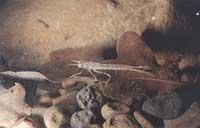
Dentists usually have several moulds before developing the mature form. These changes are mandatory. This is because the larvae are covered by a rigid overlap, so to grow it is necessary to slide the old skin and segregate another larger. This process, in general, is common to all insects. However, in the case that concerns us, entomologists talk about heterometapbolus development: the larva of heterometaphors insects has certain similarities with the adult, such as composite eyes, antennas and similar feeder and displacing appendages. But the functional reproductive organs are always missing in the larva. These mature forms usually have fry, which expand with the last mud and develop completely. In fact, the main changes in growth are due to the size and proportions of the body, regardless of the development of wings and reproductive structures.
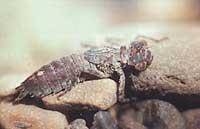
The type of development described so far, beyond the group of dentists, has been found in many other insects, such as the most orthopedic, i.e. grasshoppers. However, there are differences between grasshoppers and heterometaphorical developments of skewers and sorcerers. The most remarkable thing in the case of orthopterans, both adult and larva, would be to live in the same environment, and otherwise, in the case of dentists, that one be flying while the other is watering. Obviously, this difference has a profound biological significance, as we shall see immediately. It has also led to differences from the terminological point of view: the larva of terrestrial heterometaphors is called nymph and, as in the case of txitxiburduntzas and witches, the naiade is aqueous.
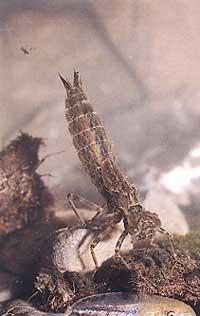
According to a widespread belief among evolutionary biologists, from the point of view of natural selection, the biological cycle with larvae and adults occupying different ecological niches is advantageous, since an ecological differentiation between young and adults is generated. That is, in the case of dentists, where the larva lives in the water and the adult in the air, intra-specific competition is completely avoided, since each has its own biological strategy to exploit as adequately as possible the resources of its environment. In any case, the satisfactory demonstration of this hypothesis is not easy and all this biological interpretation described here must be understood as a general conviction, but in no case as an empirically proven phenomenon.
In general, the development of dental eggs can be of two types: some are of rapid hatching, which open in two or three days after the ration or in a couple of weeks; others, with a late hatching, which can last for several months. Once the embryological development is complete, the young larva of the skewers and witches breaks the egg shell. The newborn is called “prolarva” and is short-lived, a few minutes. Its function is to leave the egg and reach the water. And you have to make a journey of several centimeters when the egg has been deposited in the riverside vegetation or when the water level has decreased. For this purpose the prolarva moves by jumping contracting the body, since its appendices are not functional.
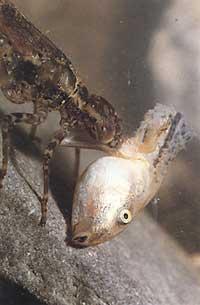
When the prolarva fulfills its function, the cuticle is torn longitudinally and the first naiade comes out. This already has the general aspect of older cards. However, in antennas and legs the first naiade has fewer keyrings, it lacks a pencil holder (= pteroteca) and its compound eyes are made up of small amounts of ommatidia. Throughout the next muds the appendices will progressively obtain the number of definitive crosses, as well as the number of ommatidia corresponding to their eyes. Likewise, from the fifth or sixth molt, the purses and incipient sexual characteristics will be erased.
The number of dumps varies between 6 and 16 dumps per species. In any case, since the dentist has to grow to a certain size, the rate of development to reach it depends mainly on the closeness of food and temperature, so that with the environmental conditions there is a change in the number of mouths in the same species. In the same way, the duration of larval development can be variable: species that needs a period of one year in southern Europe to overcome the larval period, can be prolonged for three years in high latitudes.
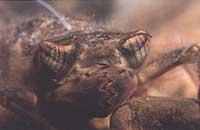
The naiades of dentists are carnivores, capturing different types of aquatic living beings. They are not specialized grains, but hunting suitable size prey such as protozoa, rotifers, mosquito larvae, small worms, water fleas, water rodents, fish fry, coplas. It has been seen that size and movement are important stimuli for the discovery of dams. However, the shape and color do not. The naiades that inhabit the same swamp, as generalist predators, are potential competitors, and based on this it has been wanted to explain the territorialist behavior of the naiades of some species to defend the place of fodder.
The naiades of the dentists do not seek prey, but wait actively spying (standing and hidden in the vegetation or buried in the sand and raft). When passing the good-sized piece, it is fastened with a powerful capping piece. This piece of mouth is the completely altered lower lip of the Nájera, with two mobile attack keys, known as “mask”. Apparently, the mechanism of this oral piece is based on the musculature of the mask itself and the abdomen: the contraction of the abdominal dorsoventral muscles increases intracorporeal pressure and the simultaneous relaxation of the flexor muscles of the lip produces the shot of the mask.
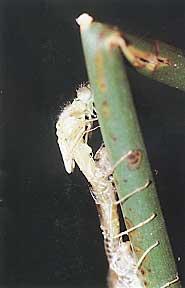
The whole process is immediate, as the extension of the mask can be 15-20 milliseconds. After the attack, the prey stuck by the keys approaches the jaws with a muscular contraction.
The amounts of food obtained by the Naiades depend, of course, on each larva and its phase, which can be important in periods of rapid growth. For example, in a one-month laboratory experiment it has been observed that a larva of txitxiburduntzi has ingested 2,136 mg of food, which after moving three times has shown a weight gain of 747 mg.
In the case of young Naiade, the detection of prey is by antennas: water movements excite the sensory organs of the antennas. In older cards the importance of vision increases, increasing equally the number of eye ommatids. Thus, the 170 ommatidia of the first larva of a txitxiburduntzi have reached 8,000 in the last orange. The new ommatidia are added in each molt to the edge of the eye, pushing back the old ommatidia, that is, the ommatídio starts looking at the previous and ends up seeing the rear.
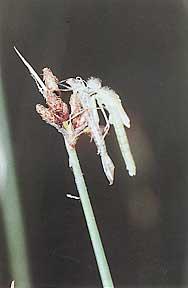
On the other hand, the way the mask is used for capture suggests that the cards are able to measure the distance. As already indicated, it is necessary to move the prey to shoot the response of the oral piece; the naiades do not respond to inert hunting. In this respect, we can mention that the composite eye is very sensitive to movement and, encoding this data, it is noteworthy that a txitxiburduntzi card can distinguish between 60 light stimuli per second, with the maximum of the human being in 45.
However, from the above-mentioned it can be thought that in the life of the trinkets and witches there is no danger. The beads are not like that, and in fact these larvae are the sustenance of trouts, fowl and some aquatic insects. Among the enemies, despite not being so visionary, there are several parasites: perhaps the best known are some exoparapsytic water mites that take advantage of the dental life cycle to fill yours.
The well adapted capture mask helps little to defend the cards. Therefore, other paths have been followed throughout evolution. The main protection strategies have been immobilization and concealment, which also serve for capture. However, the larva of dentists detected can reach more violent mechanisms. The most spectacular thing is the jet propulsion leak, made by the skewer larvae.
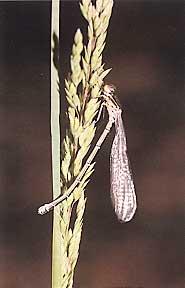
To do this, in the vicinity of a predator, they forcefully expel water from the rectum through the anus, with the larva at full speed forward. Other times they act as bodies so that for a time the enemy does not attack them. Finally, it is worth highlighting the capacity of regeneration. Thus, the legs of the larvae of the odonates are untied with relative ease of the body (phenomenon known as autotomy), abandoning the dangerous embrace of the dam and reconstructing the lost appendix along the next molts.
In our latitudes, most species are univoltins, that is, they have only one generation a year. However, when the right conditions occur, a second generation can be taken out or, otherwise, extended development for several years, as mentioned above. In tropical areas, however, there are numerous multivoltine species, that is, in a year there are several generations.
At the end of the larval period, the compound eyes develop very quickly, the southern bushes expand and the flight muscles grow. Males and females can also be distinguished. These morphological alterations are accompanied by a change in behavior: the naiadea will move through the surface, instead of deeper water, towards the shore or by submarine plants. By increasing respiratory rates, the card will periodically seek atmospheric oxygen, for which it will use the first spiral with gills and abandoned rectal breathing. It will also suspend food activity. All these changes, like total insect metamorphosis, are regulated by hormones. This period lasts for several days.

Finally, the Naiadea is prepared for the last mudú, called muda imaginal, which will bring an imago, that is, a ripe grain. The transformation occurs in the air, that is, in the posterior environment. In the early morning, two hours after leaving the water, the Nájera will climb on some stem, leaving the water definitively abandoned. It is then that the change of appearance begins, which can end at half an hour: the thorax swells and tears the surface of the larva between the bushes of the South, increasing without delay the crack, from which the thorax of the imago comes out. The legs and wings appear after the head. It will finally release the abdomen. To finish the transformation, once the “shirt” is removed from the larva, the wings must be extended and fortified. Wrinkled at the beginning, they go unraveling and stretching gradually, while they seduce. As soon as we realize, we have been completely configured the prank.
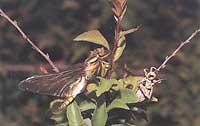
The emergency period described in all development steps is undoubtedly the most dangerous. In fact, for several hours baubles and spells are very vulnerable, being in the hands of frogs, spiders and birds. Similarly, during this period of imago emergency, wind, rain or low temperatures can cause significant damage, such as a mortality rate of 16% caused by cold weather in a population of the Anax imperator prank. From there, it can be thought that natural selection has enhanced, that old skin has been expelled quickly, that the new cuticle hardens quickly and that dentists remain as hidden as possible while doing so.
Among the flying insects there are two types of developments: heterometapbolos and holometapbolos. The latter produces a “complete” metamorphosis. For example, throughout the life cycle of the butterfly we know the caterpillar and the adult, one very voracious, the other flying, and between both the hidden phase called “pupa”, which is filled inside a hood. The metamorphosis of dentists is heterometapbolus (because there is no pupa) and the larva and adult look pretty much alike.




